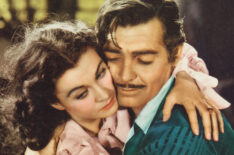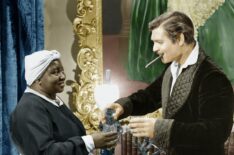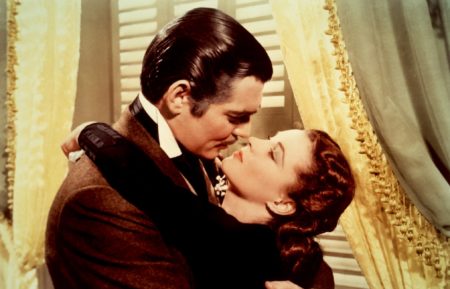The definition of American masculinity, Clark Gable was officially proclaimed the "King of Hollywood" during his Golden Age heyday. Initially considered too rough-hewn to play the romantic lead, Gable's virile persona soon earned him scores of fans in films like "A Free Soul" (1931), "Red Dust" (1932) and "San Francisco" (1936).
He won an Oscar for his role in Frank Capra's "It Happened One Night" (1934), made women swoon as Fletcher Christian in "Mutiny on the Bounty" (1935), and charmed as roguish Rhett Butler in the epic "Gone with the Wind" (1939). Gable's delivery of the latter film's classic line, "Frankly, my dear, I don't give a damn," was soon among the most quoted in the history of cinema. After distinguishing himself in combat during World War II with the Army Air Corps, Gable returned to Hollywood in 1945, albeit with a noticeably diminished spark. Although many of his late-career efforts were unremarkable, there were exceptions, such as the jungle adventure "Mogambo" (1953) and the naval action-drama "Run Silent, Run Deep" (1958).
His final performance, however, also proved to be one of his best, when he was cast opposite Marilyn Monroe and Montgomery Clift in "The Misfits" (1961). As befitting his iconic stature, America was informed of Gable's sudden passing with the reverent headline "The King is Dead."
Born William Clark Gable on Feb. 1, 1901 in Cadiz, OH, he was the son - despite being mistakenly listed as a girl on his birth certificate - of William Henry Gable, an oil-field worker, and Adeline Gable. Tragically, Gable's mother, already ill at the time of his birth, passed away before he had reached the age of one.
After remarrying in 1903, Gable's father relocated to the town of Hopedale, just outside Akron, where young Clark was raised until financial difficulties forced his father to attempt farming in the nearby town of Ravenna.
Although he was an adequate student with a keen interest in reading and music, Gable dropped out of school in 1917, and at the encouragement of a friend, traveled to Akron where he took a job at a tire manufacturing company.
It was around this time that young Gable saw his first theatrical play. Thoroughly enamored by what he saw on stage, he immediately knew what he wanted to do with his life. Financial concerns, however, made the pursuit exceptionally difficult until an inheritance allowed the then-21-year-old to travel across country to Portland, OR, where he met a woman who would dramatically alter the aspiring young actor's career trajectory.
In Portland, Gable met and eventually married the considerably older stage manager-acting coach Josephine Dillon, who quickly set about cleaning up the rough-around-the-edges wannabe actor. Following numerous voice, elocution and movement classes, Dillon - now acting as Gable's manager - took her newly-refined husband to Hollywood. Going under the stage name of C.W. Gable for a brief time, he picked up a few minor roles in such silent films as Erich von Stroheim's "The Merry Widow" (1925) and "The Plastic Age" (1925), the latter starring silent-era "It Girl" Clara Bow.
Despite the recent re-sculpting, producers saw little star potential in Gable, who returned to the stage within a few short years. After gaining valuable experience with a stock theater company, Dillon and Gable moved to New York City, where he made his Broadway debut in a production of the drama "Machinal" in 1928. His performance, described by one critic as "brutally masculine," quickly led to more work on the Great White Way. Even as his career advanced, Gable's marriage to Dillon began to crumble, while the onset of the Great Depression forced the closure of dozens of Broadway productions by the end of the decade. Within a year, Gable had left Dillon and returned to Los Angeles in the company of wealthy socialite Maria "Ria" Langham, another mother-figure, several years his senior, who he would marry in 1931.
Although he failed an early screen test with Warner Bros. producer Darryl F. Zanuck - who reportedly said of Gable, "His ears are too big. He looks like an ape" - the actor's performance in a stage production of "The Last Mile" - bankrolled by Langham - sufficiently impressed executives at RKO studios, who gave him a supporting role opposite William Boyd in the Western "The Painted Desert" (1931). Gable's fan-favorite performance as an unrepentant former outlaw in his first "talkie" earned him a contract with MGM studios, where he would remain until 1954.
In his first year alone, Gable appeared in a dozen features, quickly transitioning from supporting player - typically, as a violent thug - to romantic lead, opposite MGM's greatest leading ladies. Known as a life-long philanderer, he began an on-again/off-again affair with frequent co-star Joan Crawford during the productions of their first two films "Dance, Fools, Dance" (1931) and "Possessed" (1931). A scene in which he roughed up feisty female lead Norma Shearer in "A Free Soul" (1931) unequivocally moved Gable into star status. Not all of Gable's leading ladies were as enamored with the actor - most notably Greta Garbo, his co-star in "Susan Lenox, Her Fall and Rise" (1931), who was unimpressed with his "wooden" acting skills. For his part, Gable considered Garbo a "snob." Action sagas like "The Secret Six" (1931) - the first of six films with his female equivalent, sex symbol Jean Harlow - "Sporting Blood" (1931) and "Hell Divers" (1931) rounded out Gable's incredible, breakout year.
With such undeniable box office success under his belt, Gable was soon able to flex a bit of his newly-acquired star muscle at MGM. And although his output the following year was reduced to a more reasonable five films, the size of his roles and the range of genres he tackled both increased significantly. Having been told by studio chief Louis B. Mayer to cool off his illicit relationship with Crawford - who was married to Douglas Fairbanks, Jr. at the time - Gable directed his amorous attentions toward Marion Davies, his co-star in "Polly of the Circus" (1932) for a brief period. Onscreen, he found himself in the middle of a love-triangle opposite Harlow and Mary Astor in the hit romantic-adventure "Red Dust" (1932), directed by Victor Fleming. Gable sported his famous mustache for the first time opposite Shearer in the romantic-drama "Strange Interlude" (1932), based on a play by Eugene O'Neill. A string of hit films followed, including the romantic-drama "Hold Your Man" (1933) - his third outing with Harlow - and the star-studded aviation drama "Night Flight" (1933), which featured Lionel Barrymore, Gable's good friend from his days in the theater.
For years, Gable's casting in director Frank Capra's seminal romantic comedy "It Happened One Night" (1934) was a subject of debate. While rumors circulated that the rising star was being punished by Mayer for being overly finicky about which roles he would accept, the more pragmatic explanation was that Gable was, at that moment, uncommitted to any other project and by loaning him out to lower rent Columbia Studios for more than his salary, MGM actually made money on the deal. Regardless, there would be little doubt as to the impact of the hit film, which became the first movie to sweep the five major Oscars categories - including Best Actor for the vindicated star - and vaulted Gable to new heights of prominence. Later, anecdotal evidence not only suggested that U.S. sales of men's undershirts slumped as a result of the scene in which Gable was seen bare-chested after taking off his dress-shirt, but that the classic Warner Bros. cartoon character of Bugs Bunny was inspired by another moment in the film in which a fast-talking Gable vigorously chomped on a carrot. Regardless of the voracity of these tales, one thing was certain: Clark Gable had become the biggest male movie star in the world.
The following year proved to be even more momentous for Gable. In one of the most anticipated, lavishly-produced movies ever made at the time, he starred as the conscientious mutineer Fletcher Christian in MGM's "Mutiny on the Bounty" (1935), another Oscar-winner for Best Picture. That same year saw him in a screen adaptation of Jack London's "Call of the Wild" (1935). Confined to a remote location during the two month production, Gable, not surprisingly, engaged in an affair with his attractive young co-star, Loretta Young.
Although the tryst ended soon after filming wrapped, an unexpected by-product of the liaison arrived months later in the form of a baby girl. Fearing the disastrous effects the scandal would have on both their careers, Young went to great lengths to cover up the pregnancy. After delivering the child in private, she secretly placed Judy in an orphanage for the first 19 months of her life. Upon proudly announcing to gossip columnist Louella Parsons that she had adopted a baby girl, Young gave Judy the surname of her second husband, movie producer Tom Lewis. Eventually, rumors began to circle about Judy Lewis' true parentage, especially in light of the fact that as she grew older, she developed large ears, strikingly similar to Gable's. Raised in complete ignorance of the truth, Lewis met Gable only once when he came to visit her mother's home, but even then had no idea he was her father. Widely known within Hollywood social circles, but never publicly acknowledged by Young or Gable during their lifetimes, Lewis would not learn the truth until, at the age of 31, she finally confronted her mother about the rumors, which were confirmed.
Smash hits like the special effects-laden "San Francisco" (1936) - containing one of the actor's finest performances - thankfully overshadowed Gable's rare failures, such as the period drama "Parnell" (1937), a biopic about the doomed Irish political activist. So disastrous was the latter film that the star swore he would never act in a costume drama again. That same year, Gable appeared alongside Harlow for their sixth and final pairing in "Saratoga" (1937), which was derailed when the 26-year-old platinum blonde died tragically of kidney failure in the final weeks of production, necessitating a stand-in to complete her scenes. Around this time, Gable began courting
Without a doubt, Gable was the biggest star at MGM, if not in all of Hollywood. Audiences sang along with Judy Garland while she crooned "(Dear Mr. Gable) You Made Me Love You" in the musical extravaganza "Broadway Melody of 1938" (1937). Mickey Rooney's Gable impressions in the Busby Berkely musical "Babes in Arms" (1939) - also starring Garland - laid testament to the star's preeminent placement in the pop-culture zeitgeist of the day. Still smarting from the debacle of "Parnell," Gable was reluctant to take on a starring role in a Civil War epic being produced by David O. Selznick and based on Margaret Mitchell's best-selling novel. From the beginning, Selznick had envisioned Gable, the personification of masculinity, as the dashing rogue Rhett Butler. Much to the delight of his devoted fans who felt he was perfect for the role, MGM finally agreed to loan Selznick their biggest star, prompting a wary Gable to at last sign on for "Gone with the Wind" (1939).
With a behind-the-scenes story as epic as that depicted on screen, "GWTW" faced innumerable hurdles on its way to theaters, and, of course, Gable figured prominently in many of them. Initially, Selznick had lined up revered director George Cukor to helm the massive undertaking. A few weeks after production had begun Cukor was suddenly pulled from the film and replaced with director Victor Fleming. Although official explanations for the switch were scant, those associated with the picture acknowledged that it was Gable who had insisted on the change of director. Cukor's reputation as Hollywood's most adept director of women concerned Gable, who feared his performance would be overshadowed by those of his female co-stars, Vivien Leigh and Olivia de Havilland. Having enjoyed his experience with Fleming - a true man's man, like himself - on the successful "Red Dust," Gable successfully lobbied to place Fleming in the director's chair. Another tense moment for Gable came prior to filming the famous scene in which Butler cries. Always insecure about his range as an actor, Gable stubbornly pushed to alter the scene, until his co-star in the scene, de Havilland, buoyed his confidence in a heart-to-heart talk. He played the scene to perfection, and the fact that Gable had never shown such vulnerability on screen before made the moment all the more affecting."
"Gone with the Wind" went on to become one of the most successful, beloved films of all time, winning several Academy Awards, and earning Gable another Best Actor nomination. At the very pinnacle of his success, Gable had undoubtedly earned his title as the "King of Hollywood," an honor bestowed upon him by columnist Ed Sullivan. Not only was the period the best of his career, but it also marked a highpoint in Gable's personal life when he finally married Lombard in 1939.
Although they had first met while co-starring in 1932's "No Man of Her Own," Lombard's then-happy marriage to actor William Powell and Gable's unease with her bawdy nature kept their interaction strictly professional. It was not until a chance meeting at a party four years later that they began a torrid affair. One of Hollywood's worst kept secrets, their romance was nonetheless kept under wraps to prevent a scandal, as Gable was still married to Langham, who demanded an exorbitant amount of money before she would agree to a divorce.
As a way of convincing the star to accept the role of Rhett Butler, Louis B. Mayer increased Gable's salary to a degree that would allow him to pay off Langham, thus paving the way for the public consummation of America's favorite Hollywood couple. By all accounts, it was the most fulfilling relationship Gable had ever enjoyed, as the outspoken, liberal-minded Lombard kept him on his toes and encouraged the usually solitary Gable to become more social.
Additionally, she endeared herself to her husband by developing an appreciation for the pastimes he loved, such as hunting and fishing. Their storybook romance was cut tragically short after Lombard died in a plane crash in the mountains of Nevada in 1942 while returning from a successful war bonds fundraiser. After immediately rushing to the crash site - there were no survivors - a clearly devastated Gable returned to Los Angeles, where friends despaired as they watched the actor drink himself into oblivion while watching Lombard's old films, night after night.
In what some viewed as a death wish, the 41-year-old Gable turned his back on the movie business and enlisted in the Army Air Corps, where he served as a "motion picture specialist" and saw combat as a tail gunner during several missions over Europe. Reportedly, even Adolf Hitler was not immune to Gable's charms and offered a reward to any Nazi soldier who could deliver the Hollywood star to the Fuhrer, unscathed. After attaining the rank of Captain, Gable - who felt his age and celebrity status was preventing him from effectively serving his country - requested a discharge from active duty.
A bigger hero than ever before in the eyes of fans, Gable returned to film with much ballyhoo for the Fleming-directed "Adventure" (1945), co-starring Greer Garson. While the novelty of Gable's return initially sold tickets, the sub-par romantic-adventure ultimately proved a disappointment. Although he continued to turn out projects throughout the remainder of the decade, both Gable's zeal for filmmaking and his status as the undisputed "King of Hollywood" began to wane.
Also less successful than his previous experience, was his 1949 marriage to actress-model-socialite Lady Sylvia Ashley, a woman noted by many for her striking resemblance to Gable's dearly departed Carole. From the beginning, their relationship was a troubled one, possessing none of the mutual trust and admiration he had shared with Lombard.
Even though he was no longer the dependable box office draw he had once been, there was still no substitute for Clark Gable. When MGM remade "Red Dust" as "Mogambo" (1953), Ava Gardner was in for Harlow's character and a young Grace Kelly played the Mary Astor role. And what of Gable's part? Only Gable could fill Gable's shoes, even 21 years later. Following his divorce from Ashley and his parting ways with long-time home MGM, Gable became an independent freelance actor in 1955.
That same year he married for the fifth and final time to Kay Williams - the union would bring him some semblance of security and happiness after years of grief. After starting GABCO, his own short-lived production company formed with actress Jane Russell, Gable appeared in "The King and Four Queens" (1956) - the one and only film he both starred in and produced. Back to working as a freelance actor, Gable took a critical drubbing opposite Yvonne De Carlo and a young Sidney Poitier in the antebellum plantation melodrama "Band of Angels" (1957).
More successful was his work alongside Burt Lancaster in the wartime submarine drama "Run Silent, Run Deep" (1958), followed by a turn opposite Sophia Loren in the romance "It Started in Naples" (1960).
As he neared his 60th birthday, Gable seemed both physically and emotionally a mere shadow of the virile, life-loving man he had once been. Still, there was one final great performance left in him, although it would come at a price. Directed by acclaimed filmmaker John Huston, "The Misfits" (1961) was not merely a requiem for the mythology of the Old West, but a love letter to its star, Marilyn Monroe, written by her then-husband, playwright Arthur Miller. Starring opposite Monroe, Montgomery Clift and Eli Wallach, Gable's tragic, yet noble portrayal of a broken-down cowpoke would be regarded as one of his very finest. It would also be his last.
Prior to filming, Gable was already in poor health, having suffered at least one heart attack years earlier. His use of amphetamines to quickly drop from 230 to 195 pounds certainly could not have helped his condition. Reportedly, the aging screen icon also insisted on performing many of his stunts for the film, shot in the grueling heat of the Nevada desert. Just two days after completing work on "The Misfits," the actor suffered a major heart attack at his Encino home. Ten days later, at a Los Angeles hospital, Gable died from coronary thrombosis on Nov. 16, 1960. News of his death was announced to a mournful public via the short, somber headline, "The King is Dead."
As per his final wishes, his widow, Kay Williams, graciously buried him at Los Angeles' Forest Lawn Memorial Park, alongside his lost love, Carole Lombard. Gable was 59 years old. Months later, Williams gave birth to John Clark Gable, the son Gable had always longed for but had not lived to see.
By Bryce P. Coleman



















































































